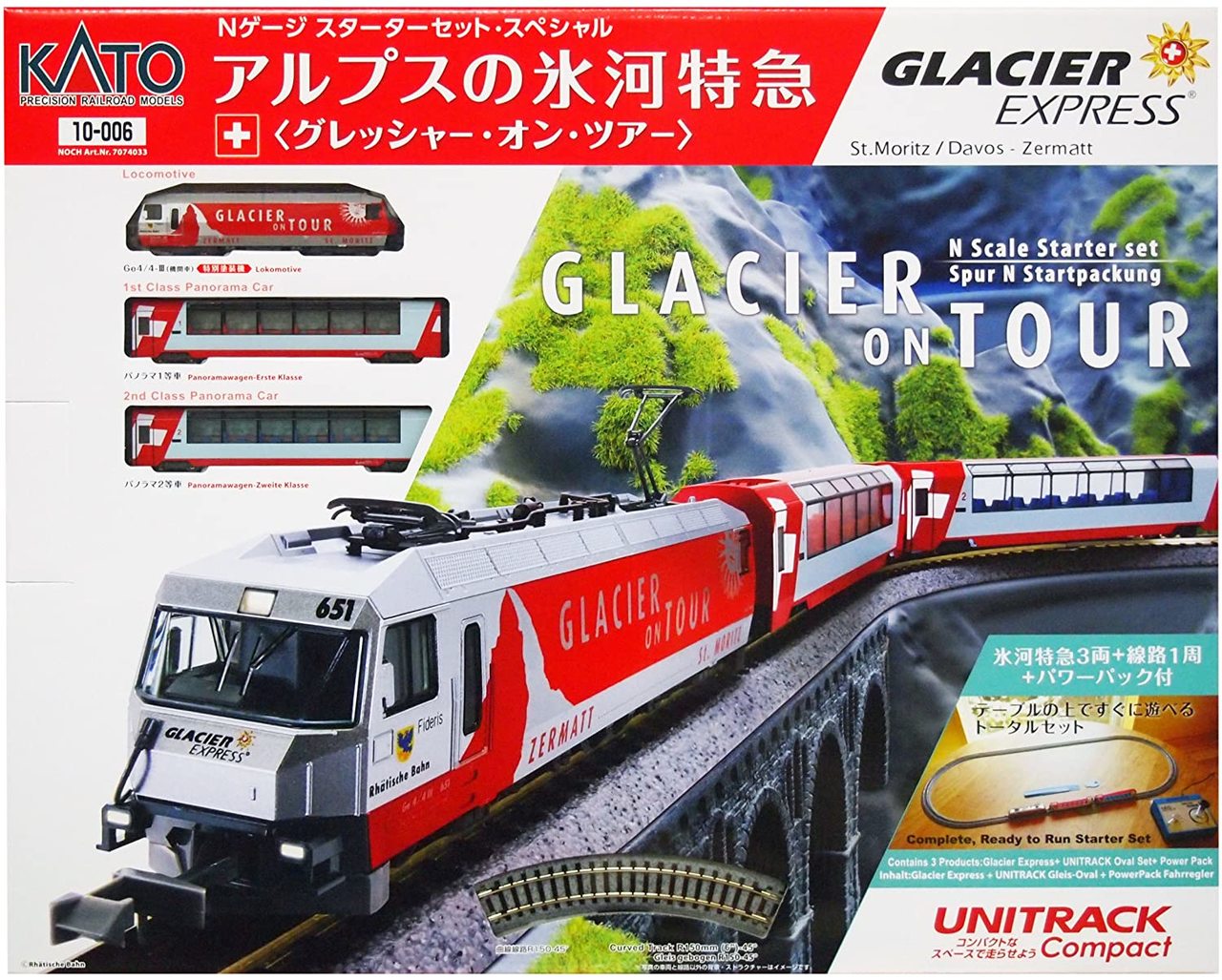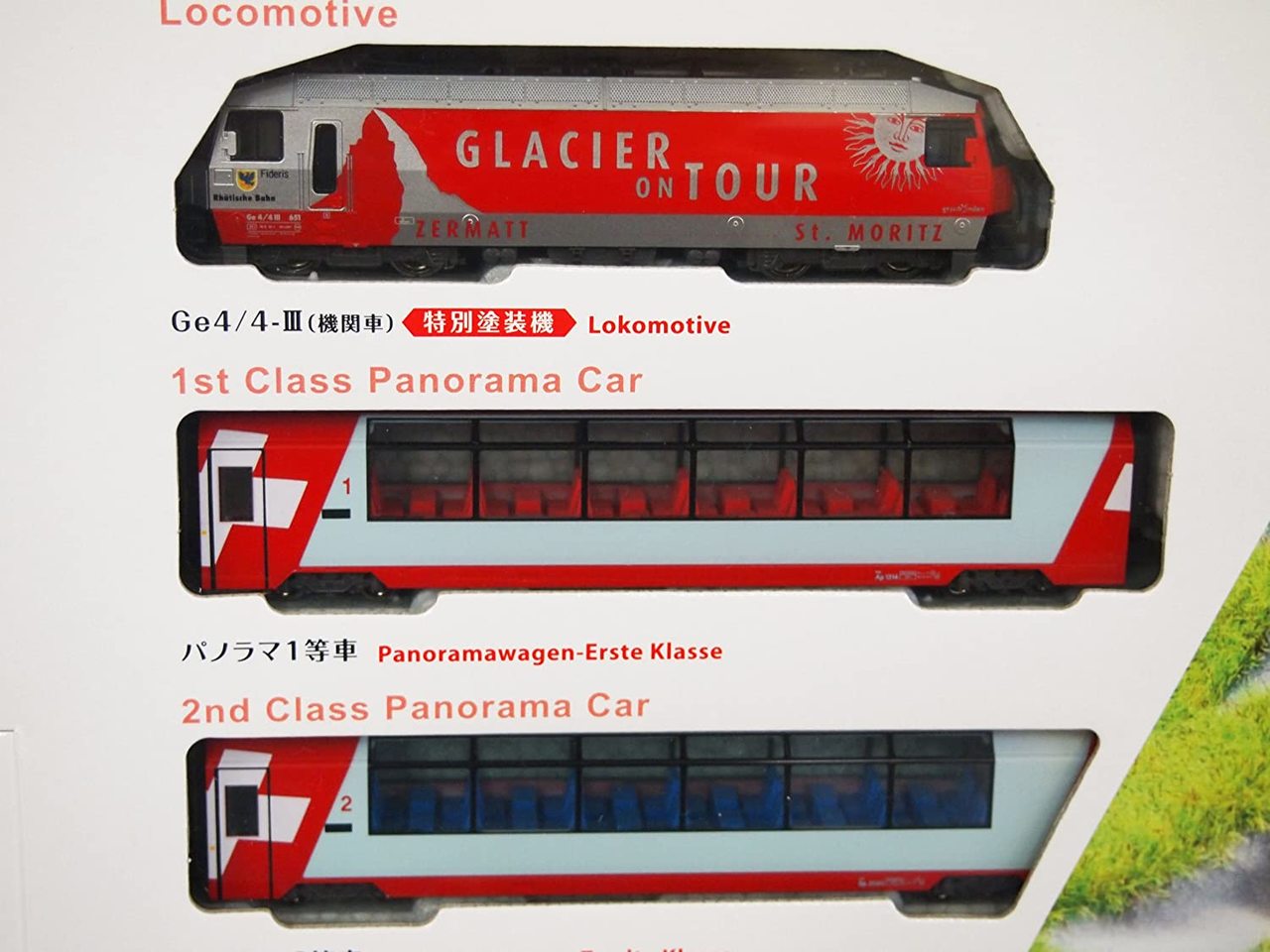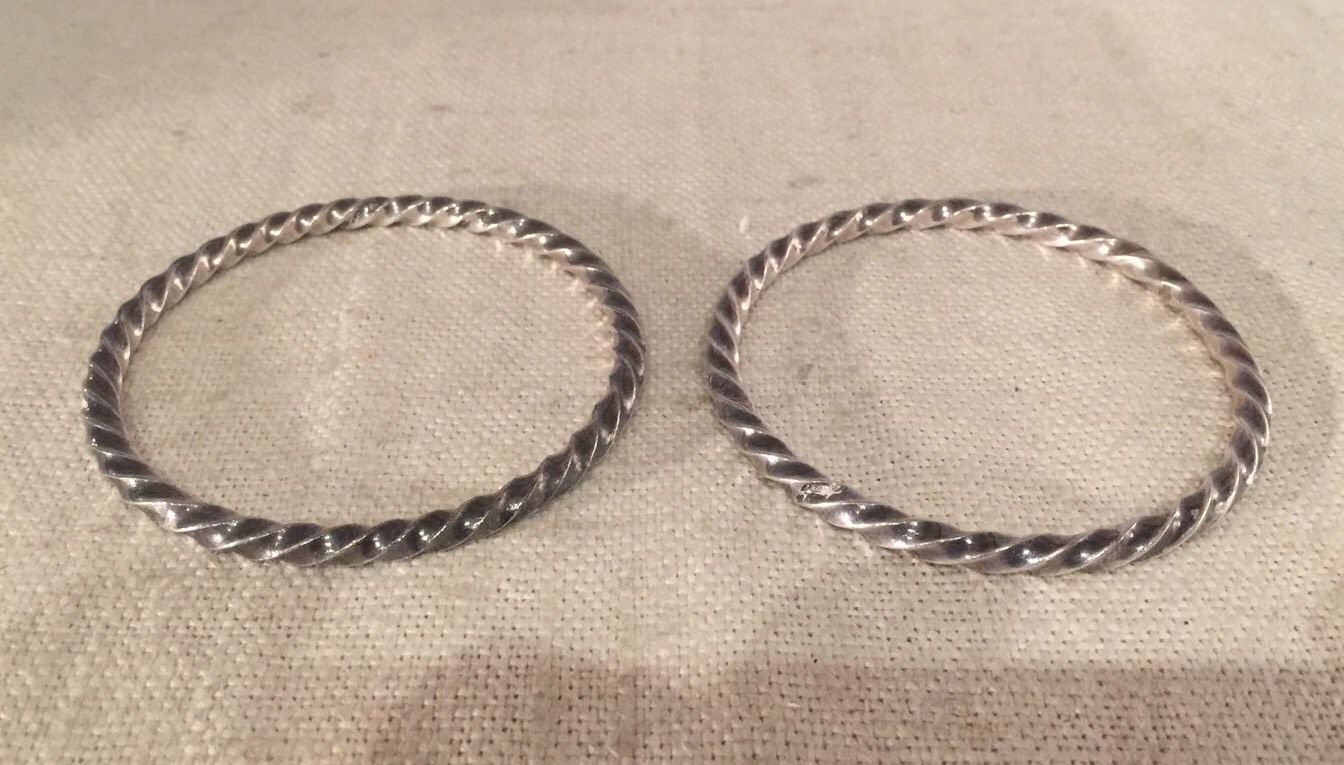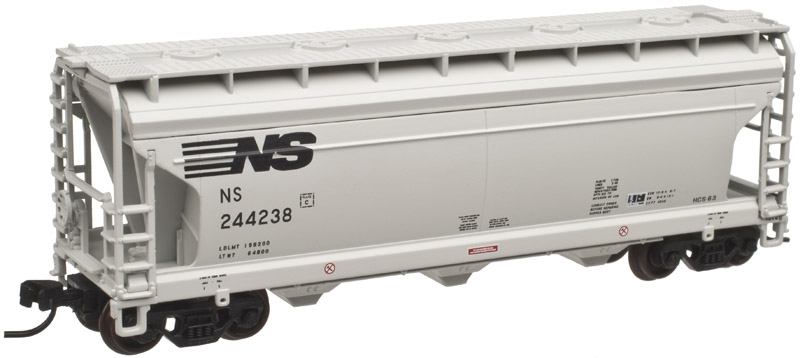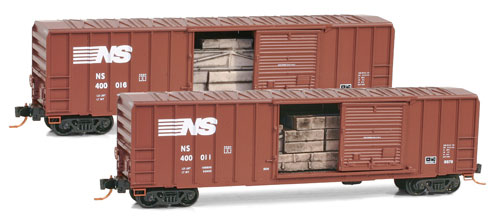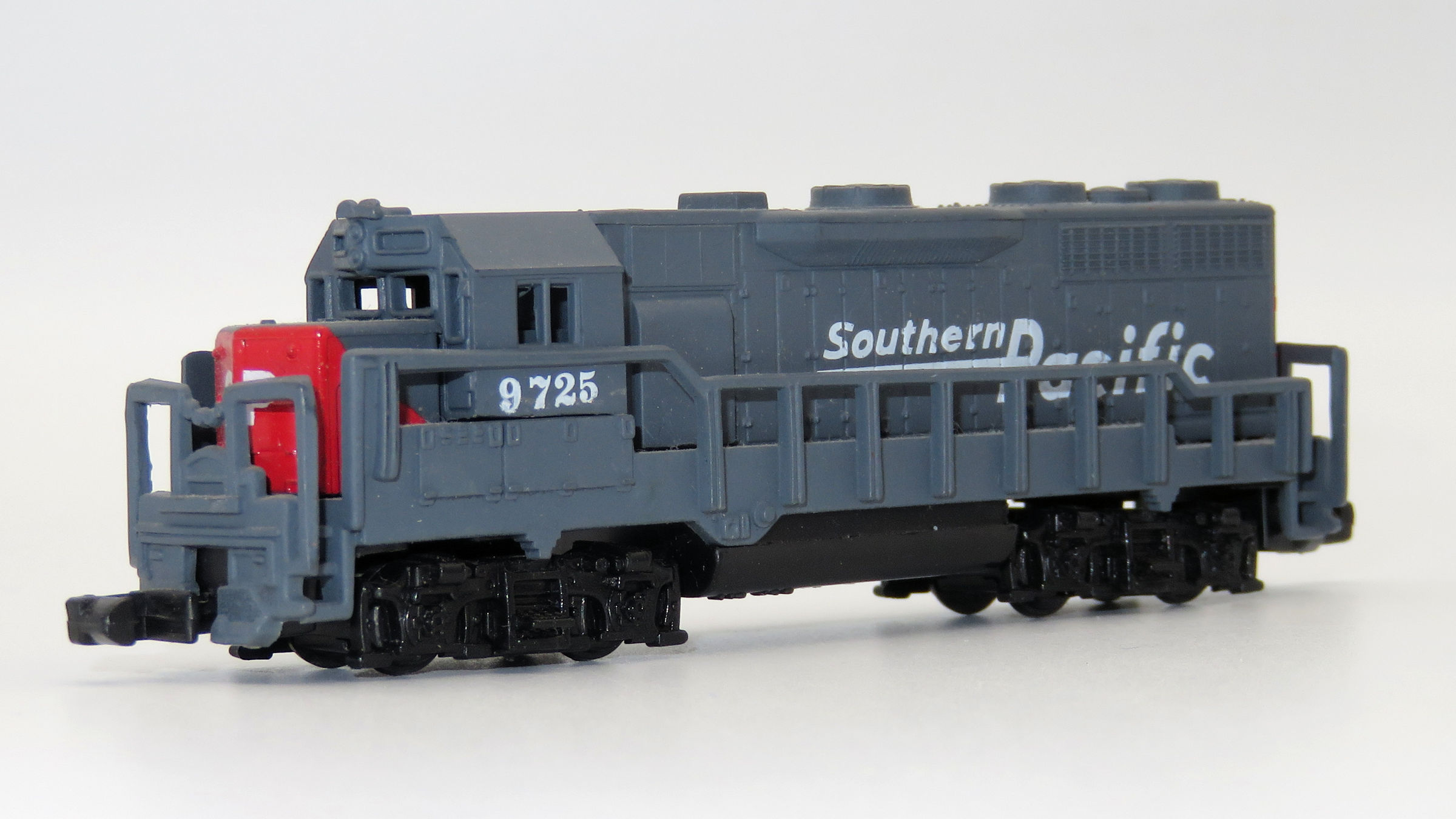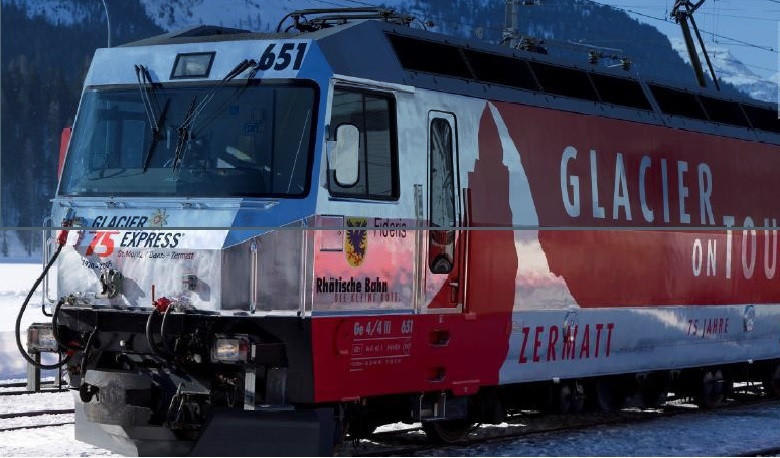Model Information: Kato boxed sets for European Prototypes come in various shapes and sizes. These may contain complete train sets with track and power pack or may be as simple as a pair of passenger coaches. Many of the sets use "bookshelf" boxes with cardboard sleeves and carefully cut foam inserts.
Prototype History: The Glacier Express (GEX) is an express train connecting railway stations of the two major mountain resorts of Zermatt and St. Moritz in the center of the Swiss Alps. The train is not an "express" in the sense of being a high-speed train, but rather, in the sense that it provides a one-seat ride for a eight-hours-long journey. In fact it has the reputation of being the slowest express train in the world. As St. Moritz and Zermatt are home to two well-known mountains, the Glacier Express is also said to travel from Matterhorn to Piz Bernina.
The journey from Zermatt starts at the dead end of a Alpine valley, the Mattertal, just below the world-renown Matterhorn at an elevation of 1,606 m (5,269 ft) before it descends to the huge valley of the Valais in Brig. It traverses the 291-kilometre-long (181 mi) journey through the center of the Swiss Alps, over 291 bridges, through 91 tunnels, such as the 15.4 km-long (9.6 mi) Furka Tunnel at an elevation of 1,500 m (4,900 ft) to circumvent the Furka Pass, makes an intermediate stop at Andermatt on a secluded high Alpine valley, just to traverse its highest point on the Oberalp Pass at 2,033 m (6,670 ft) in order to descend to its lowest point at Chur at 585 m (1,919 ft). From Chur, the capital of the canton of Graubünden the GEX backtracks to higher altitudes again in order to reach the resort St. Moritz in a further valley to the south. Previously, before traversing the Albula Range by a tunnel at 1,800 metres (5,900 ft), in Filisur travelers can change to a connecting train to reach Davos to the east.
From Wikipedia
The journey from Zermatt starts at the dead end of a Alpine valley, the Mattertal, just below the world-renown Matterhorn at an elevation of 1,606 m (5,269 ft) before it descends to the huge valley of the Valais in Brig. It traverses the 291-kilometre-long (181 mi) journey through the center of the Swiss Alps, over 291 bridges, through 91 tunnels, such as the 15.4 km-long (9.6 mi) Furka Tunnel at an elevation of 1,500 m (4,900 ft) to circumvent the Furka Pass, makes an intermediate stop at Andermatt on a secluded high Alpine valley, just to traverse its highest point on the Oberalp Pass at 2,033 m (6,670 ft) in order to descend to its lowest point at Chur at 585 m (1,919 ft). From Chur, the capital of the canton of Graubünden the GEX backtracks to higher altitudes again in order to reach the resort St. Moritz in a further valley to the south. Previously, before traversing the Albula Range by a tunnel at 1,800 metres (5,900 ft), in Filisur travelers can change to a connecting train to reach Davos to the east.
From Wikipedia
Road Name History: The Rhaetian Railway (German: Rhätische Bahn, Italian: Ferrovia Retica, Romansh: Viafier Retica), abbreviated RhB, is a Swiss transport company that owns the largest network of all private railway operators in Switzerland. The RhB operates all the railway lines of the Swiss Canton of Graub?nden/Grisons, except for the line from Sargans to the cantonal capital, Chur, which are operated by the Swiss Federal Railways (SBB CFF FFS), and the line from Disentis/Must?r to the Oberalp Pass, and further on to Andermatt, Uri, which is operated by Matterhorn-Gotthard-Bahn (MGB). Inaugurated in 1888 and expanded from 1896 onwards in various sections, the RhB network is located almost entirely within Graub?nden, with one station across the Italian border at Tirano.
The Rhaetian Railway serves a number of major tourist destinations, such as St Moritz and Davos. One of the RhB lines, the Bernina Railway, crosses the Bernina Pass at 2,253 metres (7,392 ft) above sea level and connects with the Italian railway network at Tirano, Lombardy.
In 2008, the RhB section from the Albula/Bernina area (the part from Thusis to Tirano, including St Moritz) was added to the list of UNESCO World Heritage Sites. The Albula-Bernina line is the first rail line in the world to be photographed and put on Google Street View.
From Wikipedia
The Rhaetian Railway serves a number of major tourist destinations, such as St Moritz and Davos. One of the RhB lines, the Bernina Railway, crosses the Bernina Pass at 2,253 metres (7,392 ft) above sea level and connects with the Italian railway network at Tirano, Lombardy.
In 2008, the RhB section from the Albula/Bernina area (the part from Thusis to Tirano, including St Moritz) was added to the list of UNESCO World Heritage Sites. The Albula-Bernina line is the first rail line in the world to be photographed and put on Google Street View.
From Wikipedia
Brand/Importer Information: Kato Precision Railroad Models (関水金属株式会社 Sekisui Kinzoku Kabushikigaisha) is a Japanese manufacturer of model railroad equipment in N and HO scales. The Tokyo-based company manufactures models based on Japanese prototypes (such as the Shinkansen bullet train) for the Japanese market, North American prototypes for the North American market and European high-speed trains for European market.
The Kato (pronounced kah-toe) model railroad companies were founded by Yuji Kato, father of current president Hiroshi Kato, of the parent company Sekisui Kinzoku Co., Ltd.
The design and distribution of models for the North American market are handled by their U.S. subsidiary, Kato USA, located in Schaumburg, Illinois.
The design of special models for the European market is handled for some of them by their partner, Lemke, whereas the general distribution of Kato products in Europe is handled by NOCH; both companies are located in Germany.
As a result, some Kato European models are sold as Kato Lemke and others as Kato (alone).
The Kato (pronounced kah-toe) model railroad companies were founded by Yuji Kato, father of current president Hiroshi Kato, of the parent company Sekisui Kinzoku Co., Ltd.
The design and distribution of models for the North American market are handled by their U.S. subsidiary, Kato USA, located in Schaumburg, Illinois.
The design of special models for the European market is handled for some of them by their partner, Lemke, whereas the general distribution of Kato products in Europe is handled by NOCH; both companies are located in Germany.
As a result, some Kato European models are sold as Kato Lemke and others as Kato (alone).
Commissioner Information:  NOCH was founded 1911 in Glauchau (Saxony, Germany) by Oswald Noch, the great-grandfather of the current Managing Director. NOCH offer more than 1.500 products for model building enthusiasts: terrain building, track construction, bridges and viaducts, portals, walls and arcades, scenery modelling with treees and bushes, structures, figures, vehicles and decoration items as well as model railway layouts.
NOCH was founded 1911 in Glauchau (Saxony, Germany) by Oswald Noch, the great-grandfather of the current Managing Director. NOCH offer more than 1.500 products for model building enthusiasts: terrain building, track construction, bridges and viaducts, portals, walls and arcades, scenery modelling with treees and bushes, structures, figures, vehicles and decoration items as well as model railway layouts.
NOCH is also the European importer for Rokuhan, Kato and Athearn.
 NOCH was founded 1911 in Glauchau (Saxony, Germany) by Oswald Noch, the great-grandfather of the current Managing Director. NOCH offer more than 1.500 products for model building enthusiasts: terrain building, track construction, bridges and viaducts, portals, walls and arcades, scenery modelling with treees and bushes, structures, figures, vehicles and decoration items as well as model railway layouts.
NOCH was founded 1911 in Glauchau (Saxony, Germany) by Oswald Noch, the great-grandfather of the current Managing Director. NOCH offer more than 1.500 products for model building enthusiasts: terrain building, track construction, bridges and viaducts, portals, walls and arcades, scenery modelling with treees and bushes, structures, figures, vehicles and decoration items as well as model railway layouts.
NOCH is also the European importer for Rokuhan, Kato and Athearn.
Item created by: CNW400 on 2020-06-10 17:48:42. Last edited by CNW400 on 2020-06-10 17:48:43
If you see errors or missing data in this entry, please feel free to log in and edit it. Anyone with a Gmail account can log in instantly.
If you see errors or missing data in this entry, please feel free to log in and edit it. Anyone with a Gmail account can log in instantly.


